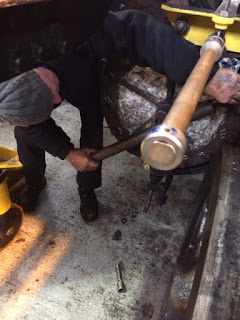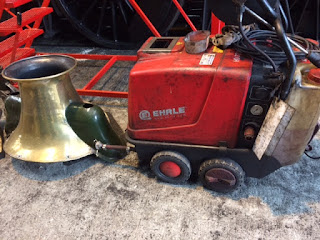Work today seemed to be going on in various areas around the David Page shed and was in part due to the wet day and the need to keep dry. One of the valve spindles from 4270 has been taken out for some cleaning and can be seen receiving attention on the bench by Ian and Roger who are giving it some care and attention to remove a build up of this crust which if left could have affected the smooth movement of the valve in the cylinder and could have lead to a failure. The very reason we need to have some annual service time during the closed season.
Meanwhile on the left hand cylinder casing of 2807, work was progressing on the cladding to replace with new insulation strips. These being glued in place prior to the cladding being refitted. Cladding in the past i.e. pre-heritage era, would have been with Asbestos and now we know the associated
hazards with that and use this modern alternative.
Whilst I was away the outer cladding had been replaced and believe this was carried out by Bruce. On the other side, Clive can be seen tightening up the bolts on the front of the cylinder which have been chalked up to indicate the correct order to ensure it is not stressed, and an even pull is applied - this provides a good seating on the face. Interestingly you can also see a gauge device protruding from the valve chest which aids the timing for the cylinder.
 |
| Clive tightens up the bolts on the front of one of the cylinders on 2807 |
 |
| The timing device as fitted (Photo by Roger Molesworth) |
The timing gadget is fitted onto the two cylinder valves so that the timing of the loco can be observed and worked on. As the valve moves, a needle attached to the end of the valve rod slides two sleeves apart (arrowed), eventually marking the end positions of travel. As for the next stage of this process we will have to wait and see!
35006, whilst not yet ready to go out on the line, was receiving some well earned TLC by Alex who took the opportunity to give the cladding a wash with some soapy water to remove some of the dust and grime that has built up whilst out of service. Alex also got the Brasso out on Thursday and it is sparkling!
 |
| Alex manoeuvres the broom to give every inch of 35006 a good scrub |
It's not only 2807 that's having insulation installed - some time is being spent keeping the draughts out of the cab in 4270, making sure that the crew keep relatively warm as well! The following few pictures show a new cover being fabricated for the side of the reverser on 4270, which until now has been open and a bit windy for the driver when out running, especially during the colder months.
 |
| Offering up the piece for a test fit |
John, Mike and Chris provided the steel plate and cleaned off the metal sheet, which as per our recycling bent, was recovered from the metal skip! Below, Joe is seen mig welding up the side flange in an unoccupied area of the shed which is well shielded by adjacent locos whilst other volunteers are having a tea break.
 |
| Joe welds up the side flange for 4270's reverser cover |
A key moment in the restoration of the GWR ballast wagon, is the fitting of the last rivet, not so much as a golden rivet but a cherry red one! A small group of volunteers have completely restored and fabricated parts for this hundred year old wagon.
 |
| Clive heats up the rivet... |
 |
| ...which is then taken by Dave, ensuring it doesn't cool too much... |
 |
| ...and inserted into the hole, while the rest of the crew appear to look on in wonderment at this beautifully glowing object... |
 |
| ...and finally the pneumatic hammer is applied by Ian to create and head and seal the rivet in place. |
Ian, Clive, Dave, Bob, Bas and Tom have now completed this part and I bet are very proud of the restoration to date.
Roger T was kind enough to send me some photos from Saturday 18th when a small amount of work was taking place on 2874. Roger was tasked with needle-gunning and wire-brushing the firebox - the paint that was put on years ago has done its job very well. It has protected it brilliantly from the elements and it wasn't very easy to remove!
 |
| Needle-gunned, wire-brushed and ready to paint |
 |
| Now painted with corrosion-inhibiting paint |
 |
| 1, 2, 3, 4... have we nearly finished yet? |
Angela was cutting a slot in the end of each of the boiler stays thereby also cutting the stay nut in half so it can easily be removed with a hammer and chisel. Roger tells me she cut 60 of the stays on Saturday - how many are left?
In 2807 news from Saturday, Roger M spent the whole day inside 2807's firebox, treating various nuts in what would normally be sat in the fire bed to a coat of heat resistant paint, rated up to 750 degrees celsius. Meanwhile, Bruce spent most of his day making new felts for the piston rod lubricators. He happened to find a tin that was the same diameter as the rods which proved a handy template to cut out the new felts. The top felts have curved lower surfaces to fit around the rods and they're held in place with a metal cover.
 |
| New piston rod lubricator felts |
The lower felt is just a strip that fits inside the bottom part - above you can see some of the felts sitting in oil ready for fitting.
Last week I was burning the midnight oil and forgot my little addition of a countdown to the new season. I'm back on form now and you can find it down the bottom of the page as always.
As a bit of fun, Roger M has produced this backhead parts naming quiz - how many can you name?
 |
| 2807 backhead parts naming quiz |





It's nice to see some work,going on,on 2874!.Should look good,when completed!.Great Western green.And I've read somewhere,a tall safety valve bonnet!.Hope I'm still around,to see it!. Regards. Anthony.
ReplyDeleteMy grandson who is only three, loves motorcycles, cars, basically anything with a motor or an engine. He wants to know everything about each part and what it does. Having said that, he is obsessed with trains! Especially the steam engines. He knows a lot about the parts and how they work. This is a post I'll have to show him.
ReplyDeleteGerman Zollinger @ Total Clean Equip